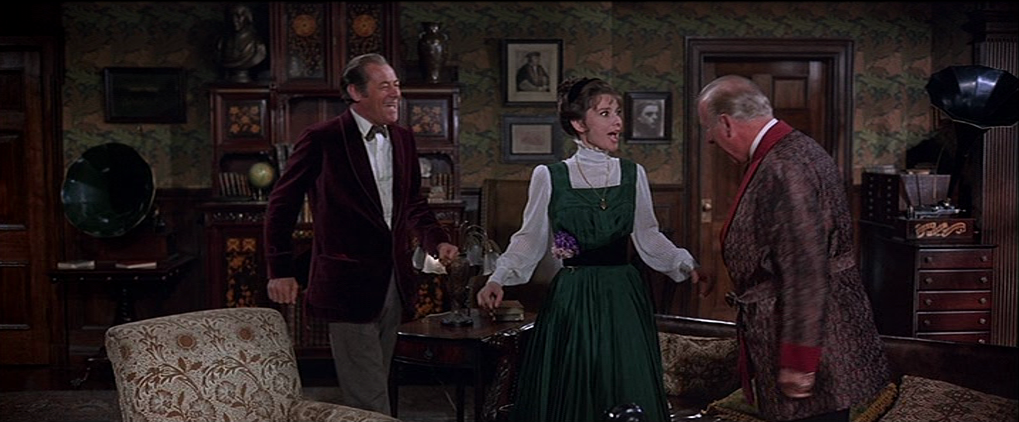How is “My Fair Lady” a theatrical film?
Despite being one of the most famous and beloved musicals of the Hollywood studio era, George Cukor’s My Fair Lady (1964) was never an intuitive choice for cinematic adaptation. Based on George Bernard Shaw’s supremely talky, very stagebound Pygmalion (which also somehow inspired an excellent film adaptation), My Fair Lady is unabashedly theatrical. Every aspect of the work is neatly tailored to the theater and the exact opposite of what is generally considered to be cinematic: there is a great deal of dialogue and song and little action; long scenes take place in a single setting with little opportunity for opening things up by shifting location; it takes place almost entirely indoors; even the film’s climax is not a grand gesture, but a man singing a song and slowly comprehending his own feelings.
Legendary (and rarely adapted) musical theater composer Stephen Sondheim has asserted on multiple occasions that the only effective movie musicals are those written specifically for the screen because adaptations of stage shows are weighed down by their inherent theatricality. Many stage-to-screen adaptations attempt to make their stories more cinematic by including exterior shots and changing the context in which songs and scenes occur - sometimes, this is highly effective, but often not. What sets My Fair Lady apart from these other adaptations is the way the film embraces its own staginess.

The film’s sole concession to the demands of film is the addition of a ball scene - an event that occurs offstage and is later described by the characters in the stage version. However, the film otherwise maintains the structure, intimacy, and lengthy dialogue of the original.
One of the ways in which the film remains staunchly theatrical is not a stylistic choice on the part of the filmmakers, but a fundamental aspect of the text: the interiority of the songs. In a musical written specifically for the screen, action is frequently written into songs. Consider, for example, the “Isn’t It Romantic” sequence in Love Me Tonight (1932). Star Maurice Chevalier begins the song, which spreads infectiously to his customer, a passing cab driver, the cabbie’s customer, a group of soldiers, a passing gypsy musician, and eventually a gypsy choir. As they sing, the song wafts up to the nearby mansion of leading lady Jeanette MacDonald, who picks up the tune herself. In this one number, the film covers vast geographical space, introduces the two leads, and points to their eventual, inevitable coming together in a way that could only be accomplished with the aid of cinematic editing.
While some stage works have attempted to cover multiple locations and forward plot in a similar manner, a typical musical song pauses the movement of plot to explore characters’ inner lives, revealing the evolution of their thoughts and feelings. My Fair Lady is typical in this way: none of its songs involve action or the forwarding of plot, but instead stop time and allow the characters to articulate the things they can’t express in dialogue or gradually tease out complex, conflicted emotions. This approach to song is taken to its logical extreme in the climactic “I’ve Grown Accustomed to Her Face”, essentially an argument between Rex Harrison’s Henry Higgins and himself, in which he ping-pongs between verbose rage and understated, grudging lyricism as he comes to realize that he might be in love. The scene is the least cinematic sequence imaginable: it consists solely of Harrison walking around London or standing outside his front door, simply acting. Making the scene cinematic is not a possibility - it is a song that, by design, hinges purely on the development of character and the exquisite interplay of words and music.
While much of My Fair Lady’s theatricality is inherent in the structure and style of the source material, it is also due in large part to filmmaking choices that attempt to approximate the feeling of watching a musical onstage. The production design is overtly theatrical with unabashedly artificial exteriors and the actors’ frequent “cheating”, or playing out to the audience. The Ascot scene takes this a step further and transplants a theatrical image wholesale into the film. Traditionally in onstage presentations of the song “Ascot Gavotte”, a chorus of prim aristocats line up and look out into the audience as they “watch the horse race”. Cukor recreates this image exactly. Not even the half-hearted addition of some horses can render this distinctly theatrical image cinematic - and Cukor doesn’t appear to have any interest in doing so.
Even more fundamentally, My Fair Lady truly embraces its theatricality at the most basic level of framing and shot length, employing cinematic language that attempts to approximate the experience of watching a play in the theater. The film features almost no closeups; it is primarily made up of medium shots. This framing creates both distance from and intimacy with the actors in a way that is similar to how an audience member experiences their relationship with a performer in a proscenium theater. The film also makes extended use of long takes. Editing creates meaning and expresses a pont of view - each cut shapes an actor’s performances and dictates the viewer’s perception of the action onscreen. By using such long takes, My Fair Lady allows the performers the wholeness and autonomy that theater actors enjoy.
The differences between movie musicals and musical theater are vast - in adapting a work of musical theater to film, it is almost impossible to overcome the profound, fundamental differences in structure and the function of music. While many musicals struggle mightily to overcome this problem, My Fair Lady builds its identity as a film on it. Rather than attempt to make a deeply theatrical work cinematic, it doubles down, employing a specific cinematic language to recreate the feel of theater onscreen.

